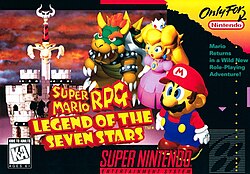Super Mario RPG
| Super Mario RPG | |
|---|---|

North American box art depicts (from left to right) Bowser, Princess Toadstool, and Mario
|
|
| Developer(s) | Square |
| Publisher(s) | Nintendo |
| Director(s) | Yoshihiko Maekawa Chihiro Fujioka |
| Producer(s) | Shigeru Miyamoto |
| Writer(s) |
Kensuke Tanabe Atsushi Tejima |
| Composer(s) | Yoko Shimomura |
| Platform(s) | Super Nintendo |
| Release date(s) | |
| Genre(s) | Role-playing |
| Mode(s) | Single-player |
| Aggregate score | |
|---|---|
| Aggregator | Score |
| GameRankings | 89% |
| Review scores | |
| Publication | Score |
| 1UP.com | A |
| AllGame | |
| EGM | 8.75 of 10 |
| IGN | 9.5/10 |
| RPGamer | 4 of 5 |
Super Mario RPG (Japanese: スーパーマリオRPG Hepburn: Sūpā Mario Āru Pī Jī?), subtitled Legend of the Seven Stars in its North American release, is a role-playing video game developed by Square (now Square Enix) and published by Nintendo for the Super Nintendo Entertainment System. It was originally released on March 9, 1996, in Japan and on May 13, 1996, in North America. Nintendo ported the game, with minor differences, to the Wii's Virtual Console service in 2008 and to the Wii U's Virtual Console service by late June 2016 to regions around the world. It is the first role-playing video game in the Mario series. The game contains fundamental gameplay similarities and inspirations to other Square role-playing video games, such as the Final Fantasy series, with a story and action-based gameplay derived from the Super Mario Bros. series.
The story focuses on Mario and his party as they seek to eliminate the game's main antagonist, Smithy. Smithy has stolen the seven star pieces of Star Road where all the world's inhabitants' wishes become Wish Stars, and Mario must return the pieces so these wishes may again be granted. The game features five permanent playable characters. Super Mario RPG was directed by Yoshihiko Maekawa and Chihiro Fujioka and produced by Shigeru Miyamoto. Yoko Shimomura composed the game's score, which was released on a soundtrack album in Japan shortly after the game's debut.
...
Wikipedia
